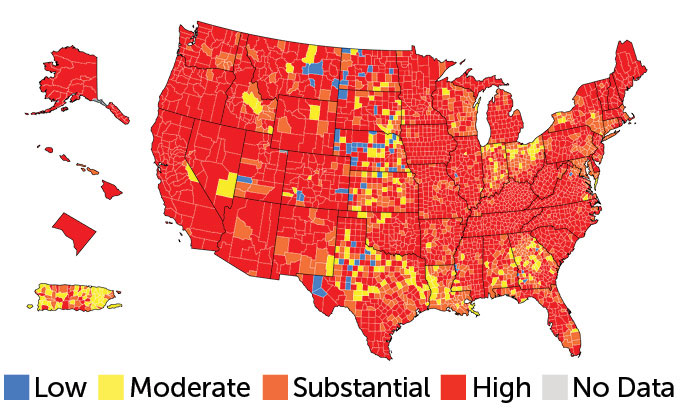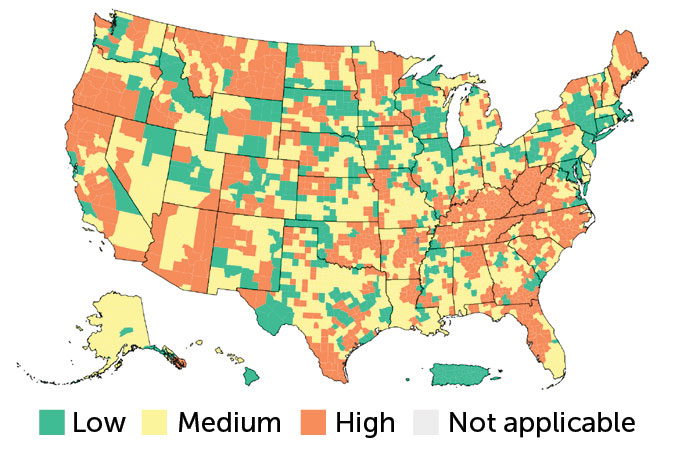How to interpret the CDC’s new mask guidelines
The coronavirus hasn’t gone away, but the agency now calculates risk differently

A shift in how the U.S. Centers for Disease Control and Prevention calculates COVID-19 risk means that many residents across the country now live in areas with low transmission, and masks are optional.
Yulia Shaihudinova/Moment/Getty Images Plus
By Tina Hesman Saey and Erin Garcia de Jesús
- More than 2 years ago
One moment, Campbell County in Wyoming’s northeastern corner was an area of high levels of transmission of the coronavirus, a scenario in which the U.S. Centers for Disease Control and Prevention recommends that everyone wear a mask indoors in public places. In the space of a breath, that county got the green light from the CDC that everyone could remove their masks.
Campbell County is not alone. By one measure, in the week of February 20 to February 26, 91 percent of U.S. counties had high or substantial levels of community transmission of the coronavirus, the CDC calculated. The agency recommended wearing masks under those conditions (SN: 2/12/21). Yet on February 25, just 37.3 percent of counties were considered high risk and in need of masks, the agency projected. How could communities be in the Schrödinger’s cat position of simultaneous mask-on high and mask-off low risk?
Transmission levels of the virus hadn’t changed, but the way that the CDC calculates risk did. Under previous guidelines, case counts were the most important measure. The CDC labeled counties that exceeded 50 new COVID-19 cases per 100,000 people in the past week or had 8 percent of tests coming back positive as places with substantial or high transmission.
Previous guidance
The CDC’s old metrics relied on only case counts to determine COVID-19 transmission risk in a community. As a result, much of the country was in the high or substantial levels. Counties with 100 cases or more per 100,000 people or 10 percent or more of positive tests were considered at high transmission risk (red), with lower figures indicating substantial (orange), moderate (yellow) or low (blue).
U.S. COVID-19 transmission levels by county, February 20–26

With the new guidelines, the CDC shifted focus to levels of severe disease. Case counts are just one of three numbers used to calculate risk. The new metrics raise case thresholds for wearing masks and other precautions to 200 weekly cases per 100,000 people. Below that level of cases is now considered low risk, as long as the number of hospital admissions and percent of hospital beds occupied by COVID-19 patients are also low.
Higher case levels or more hospitalizations — both new admissions and beds filled — mark moderate or high transmission areas, and that’s when recommended public health measures, such as masking and testing, start phasing in again. Individuals can check their county’s COVID-19 levels using an online tool from the CDC.
The focus on hospitalization aims to provide a glimpse at whether local health care systems have the ability to weather a new COVID-19 surge, CDC director Rochelle Walensky said February 25 at a news briefing.
New metrics
The CDC’s updated metrics for COVID-19 risk take both case levels and hospitalizations in a community into account. As a result, less of the country is now in the high level. Fewer cases and hospitalizations per 100,000 people in the last seven days mean low transmission (green) while higher numbers indicate medium (yellow) or high (orange) levels.
U.S. COVID-19 community levels by county as of February 24

Now is a good time for such a move, Walensky said. “We’re in a stronger place today as a nation with more tools to protect ourselves in our communities from COVID 19,” she said. With more people across the country vaccinated or recovered from prior infections, the risk for severe disease and hospitalization is lower overall for most people (SN: 2/24/22). New COVID-19 treatments also keep people out of the hospital or reduce the number of days they stay there (SN: 12/21/21).
CDC’s move brought both praise and criticism. On the positive side, the guidelines are based on the most important measurement: levels of severe disease. And masking isn’t the only prevention measure recommended under the guidance: testing, treatments, vaccines and ventilation are also covered (SN: 1/11/22; SN: 12/15/21; SN: 5/18/21). All of which can be dialed up or down as needed to combat new surges, the agency said.
But there are drawbacks, too. “These guidelines might delay the response of states and communities to new surges until there’s already a high level of severe disease and death in a community, [which] might ultimately lead to higher levels of severe disease and death,” says Alyssa Bilinski, an infectious diseases modeler at the Brown School of Public Health in Providence, R.I. That delay comes because people tend to be sick with COVID-19 for a week or more before they go to the hospital.
Imperfect science
Choosing which number or numbers to base public health policy on isn’t easy and is always imperfect, says epidemiologist Jay Varma, director of Weill Cornell Medicine’s Center for Pandemic Prevention and Response in New York City.
One reason for CDC’s new reliance on hospitalization numbers may be that it’s now harder than before to tell exactly how many people have COVID-19, just based on case counts, he says. Except in the earliest stages of the pandemic, public health officials always knew they were missing some COVID-19 cases, but people’s motivation to get tested was high, testing was readily available, and results of tests were almost always reported. “All three of those things have changed, making it necessary to change your strategy,” Varma says.
Now, even though tests are still widely available, the motivation to test has declined, and more people are testing at home. Those at-home test results aren’t usually reported, leaving public health officials in the dark about how much illness is in the community. Hospitalization numbers and hospital capacity are more accurate measures than case rates and may give public health officials a more solid idea of what’s happening.
“With the tools we have available, I think CDC chose the best options available,” Varma says.
Still, the higher case threshold of 200 cases per 100,000 population that would trigger mask recommendations seems tied to the highly transmissible, but relatively mild omicron variant (SN: 3/1/22).
“Omicron is the most infectious respiratory virus I have ever seen. I’ve never seen a virus spread through a population this fast,” Varma says. But high levels of immunity and a perhaps milder virus means that omicron didn’t cause as many hospitalizations as previous versions of the virus did. That new case threshold may need to be revised downward if another variant that is as contagious as omicron, but nastier, comes along, he says.
New surveillance strategies, built on existing systems, could help researchers keep an eye out for such variants, he says. Throughout the United States, communities take random surveys of doctors’ offices and emergency rooms to see how much influenza-like illness is in the community. The same could be done for COVID-19, he says. In addition, people with respiratory illnesses should be tested for COVID-19, flu and other respiratory viruses at the same time.
One metric Varma says he would not add to CDC’s calculations is vaccination rates, though some people have suggested that. To some extent, vaccination rates are baked into the numbers already because vaccines prevent hospitalization and death, which would be reflected in the new admissions and hospital capacity numbers (SN: 8/31/21). But vaccination rates aren’t as helpful in determining whether people should put on masks to avoid respiratory illnesses.
“Masks are important because they prevent any type of infection. Whereas, vaccinated people can still acquire infection and transmit it to each other,” Varma says. Folding vaccination rates into the equation “might lead you to erroneously think that even though the case numbers are very high, a highly vaccinated population might not need masks as much as a less vaccinated population.”
Shifting responsibility
With many politicians and members of the public eager to see an end to pandemic restrictions, CDC’s new guidelines are also a nod to the current political and social climate.
“Right now there’s a movement toward shifting the burden of preventing severe outcomes from COVID-19 from the community onto individuals, particularly individuals who are at higher risk,” Bilinski says. “It has been frustrating how forgotten immunocompromised and other vulnerable people are in these discussions.” Children 5 years old and younger, not yet eligible for COVID-19 vaccines, fall into that group of vulnerable people too.
If public health burdens are being shifted onto individuals’ shoulders, policies should make it easier for people to protect themselves with free N95 masks and testing for those people and their families, she says.
The new metrics are “a move in the right direction,” says Tina Tan, a pediatric infectious diseases physician at Northwestern University’s Feinberg School of Medicine and Ann & Robert H. Lurie Children’s Hospital of Chicago. But, she says, masks and other public health measures remain important for kids who are too young to get vaccines and the people around them. Though, if there’s less disease circulating in the community overall, then kids will have a lower risk of exposure to the virus, she notes.
Still, Tan doesn’t think everyone will be dropping their masks so quickly. “To wear a mask in areas where you have low to medium transmission is a personal decision,” Tan says. “And there are still going to be a lot of people — myself included — who will continue to wear masks in those situations.”
The CDC’s new guidelines are not intended to discourage wearing masks, Walensky said during the news briefing. “Anybody is certainly welcome to wear a mask at any time,” she said. “We are absolutely endorsing if you feel more comfortable wearing a mask, feel free to do so.”
When making that personal decision, “You should be designing your precautions based on the most vulnerable people in your group,” Bilinski says, “the cancer patients in your life, or the people in assisted living.”
She expects to see less masking in the coming weeks and says that’s appropriate if cases and hospitalizations continue their downward trajectory. “But I still hope people are very ready to put masks back on and think about other precautions when there’s signs of a new surge.”
Sign up for our newsletter
We summarize the week's scientific breakthroughs every Thursday.







